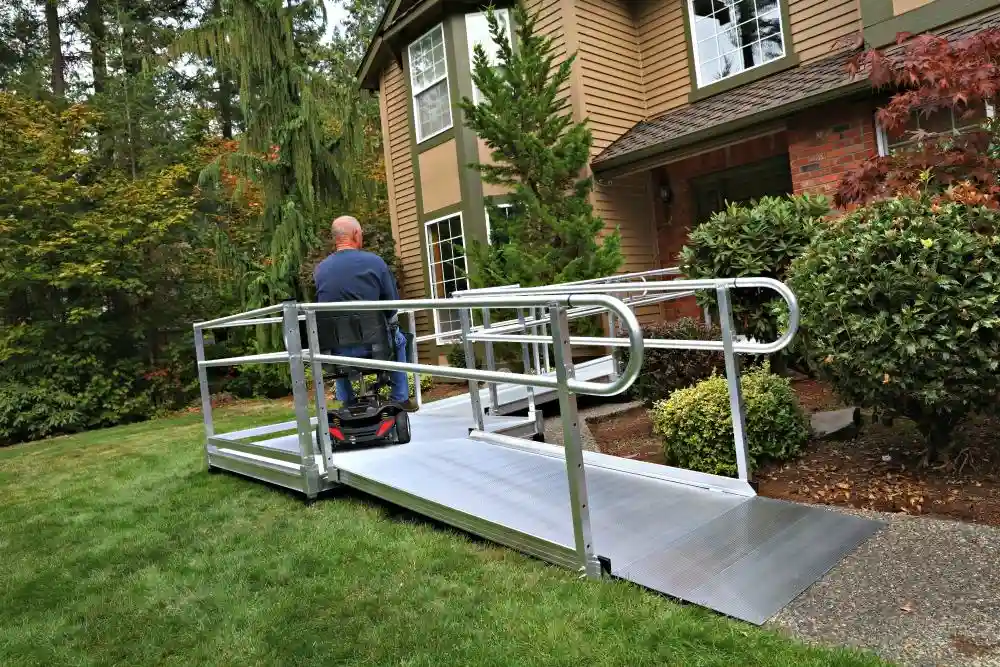In this article, we will explore the importance of residential wheelchair ramps in promoting a sense of belonging and improving the well-being of seniors. These ramps are vital for individuals with mobility challenges, allowing them to navigate their homes safely and independently.
By understanding the various types of residential wheelchair ramps available, homeowners can make informed decisions to enhance accessibility and safety within their homes.
Additionally, we will discuss the benefits of incorporating these ramps, such as increased independence and improved quality of life for seniors.
Join us as we delve into the world of residential wheelchair ramp types and their positive impact on senior well-being.
Key Takeaways
- Residential wheelchair ramps enhance accessibility and independence for seniors with mobility challenges.
- Different types of ramps are available, including threshold ramps, portable ramps, modular ramps, and permanent ramps, each with its own advantages and suitability for specific situations.
- Factors to consider when choosing a residential wheelchair ramp include the individual’s needs, recommended slope guidelines, ramp material, and dimensions.
- Installing a residential wheelchair ramp offers numerous benefits, including improved access throughout the home, enhanced safety, increased independence, and social inclusion, significantly improving senior well-being.
Importance of Residential Wheelchair Ramps
The importance of residential wheelchair ramps lies in their ability to enhance accessibility and independence for seniors with mobility challenges. These ramps provide a safe and convenient way for individuals in wheelchairs to navigate their homes and surrounding areas.
By having a wheelchair ramp installed, seniors can easily enter and exit their homes without relying on assistance from others. This promotes a sense of independence and self-reliance, allowing seniors to maintain their dignity and freedom.
Furthermore, residential wheelchair ramps also improve the overall safety of the home by reducing the risk of falls and accidents that can occur when navigating stairs or uneven surfaces.

Different Types of Residential Wheelchair Ramps
There are several distinct types of residential wheelchair ramps that can be installed to enhance accessibility for seniors with mobility challenges. These ramps are designed to provide a safe and convenient way for individuals using wheelchairs or mobility scooters to navigate different levels of their homes. Here are four common types of residential wheelchair ramps:
- Threshold ramps: These ramps are used to bridge small height differences, such as door thresholds or small steps. They are lightweight and portable, making them easy to install and remove as needed.
- Portable ramps: These ramps are also lightweight and can be easily moved from one location to another. They are typically made of aluminum and can be folded for convenient storage.
- Modular ramps: These ramps are more permanent in nature and are often used for homes with higher elevation changes. They consist of interlocking sections that can be customized to fit the specific needs of the home.
- Permanent ramps: These ramps are built to be a permanent fixture of the home. They are typically made of concrete, wood, or metal and require professional installation.
Factors to Consider When Choosing a Residential Wheelchair Ramp
When choosing a residential wheelchair ramp, it is important to consider various factors that will ensure optimal accessibility and safety for seniors with mobility challenges.
One of the first factors to consider is the type of ramp that will best suit the individual’s needs. There are different types of ramps available, such as modular ramps, threshold ramps, and portable ramps, each with its own advantages and suitability for specific situations.
Another important factor to consider is the slope or incline of the ramp. It is essential to ensure that the ramp meets the recommended slope guidelines to prevent accidents and ensure a smooth and safe transition for wheelchair users.
Additionally, the material of the ramp should be considered, as it should be sturdy, durable, and weather-resistant to withstand various environmental conditions.
Finally, the size and dimensions of the ramp should be adequate to accommodate the wheelchair and provide sufficient space for maneuverability.
Benefits of Installing a Residential Wheelchair Ramp
Installing a residential wheelchair ramp offers numerous benefits for seniors with mobility challenges. Here are four key advantages of installing a residential wheelchair ramp:
- Improved Access: A wheelchair ramp provides a smooth and inclined surface, allowing seniors to easily navigate doorways, thresholds, and steps. This eliminates the need for assistance or the use of alternative entrances, ensuring that seniors can move freely throughout their homes.
- Enhanced Safety: Wheelchair ramps are designed with non-slip surfaces and handrails to prevent slips, trips, and falls. This reduces the risk of accidents and injuries, providing seniors with a secure and stable pathway.
- Increased Independence: By having a wheelchair ramp, seniors can maintain their independence and perform daily activities without relying on others for assistance. They can enter and exit their homes without barriers, improving their overall quality of life.
- Social Inclusion: With a residential wheelchair ramp, seniors can comfortably welcome friends, family, and guests into their homes. This promotes a sense of belonging and community, allowing seniors to socialize and engage in meaningful connections.
How Residential Wheelchair Ramps Improve Senior Well-being
Residential wheelchair ramps significantly enhance senior well-being. These ramps provide seniors with the ability to navigate their homes safely and independently, improving their overall quality of life.
By eliminating the barriers posed by stairs, wheelchair ramps ensure that seniors can easily move between different areas of their homes, reducing the risk of falls and injuries. This increased mobility also allows seniors to engage in activities they enjoy and maintain their social connections, promoting a sense of belonging and preventing feelings of isolation.
Furthermore, residential wheelchair ramps promote physical well-being by encouraging seniors to remain active and mobile. With the installation of these ramps, seniors can continue to age in place comfortably and confidently, maintaining their independence and overall well-being.
Tips for Maintaining and Ensuring Safety of Residential Wheelchair Ramps
To ensure the continued safety and functionality of residential wheelchair ramps, it is important to regularly maintain and inspect them. Here are some tips to help you maintain and ensure the safety of your residential wheelchair ramp:
- Regular cleaning: Clear debris, leaves, and other obstructions from the ramp surface to prevent slips and falls.
- Check for damage: Inspect the ramp for any signs of wear and tear, such as cracks, loose bolts, or rust. Repair or replace any damaged parts promptly.
- Secure handrails: Ensure that the handrails are securely fastened and at the proper height for stability and support.
- Monitor slope and surface: Check the ramp slope to ensure it meets the recommended guidelines. Also, make sure the surface is even and slip-resistant.
Frequently Asked Questions
Are Residential Wheelchair Ramps Only Necessary for Seniors?
Residential wheelchair ramps are not only necessary for seniors but also for individuals with mobility issues. They provide safe and accessible entry to homes, promoting independence and improving quality of life for people of all ages and abilities.
Can Residential Wheelchair Ramps Be Customized to Fit Specific Home Layouts?
Yes, residential wheelchair ramps can be customized to fit specific home layouts. This customization ensures that seniors and individuals with mobility challenges can safely navigate their homes while maintaining their independence and well-being.
What Materials Are Commonly Used for Residential Wheelchair Ramps?
Common materials used for residential wheelchair ramps include wood, aluminum, and concrete. These materials provide durability and stability, ensuring safe access for seniors with mobility challenges.
Do Residential Wheelchair Ramps Require Any Special Maintenance?
Residential wheelchair ramps do not require any special maintenance. However, regular inspections should be conducted to ensure the ramp is in good condition. Any loose or damaged parts should be repaired or replaced promptly to maintain safety and functionality.
Are There Any Regulations or Guidelines for the Installation of Residential Wheelchair Ramps?
Yes, there are regulations and guidelines for the installation of residential wheelchair ramps. These guidelines ensure that ramps are safe and accessible for individuals with mobility impairments, promoting independence and well-being.
Conclusion
In conclusion, residential wheelchair ramps play a vital role in enhancing the well-being of seniors by providing safe and accessible solutions for mobility challenges.
By understanding the different types of ramps available and considering factors such as design and materials, homeowners can make informed decisions when choosing the most suitable ramp for their needs.
The installation of these ramps offers numerous benefits, including improved accessibility, increased safety, and enhanced quality of life for seniors. Regular maintenance is essential to ensure the longevity and safety of residential wheelchair ramps.
You may also like to read:
Benefits Of Chiropractic Spinal Decompression



